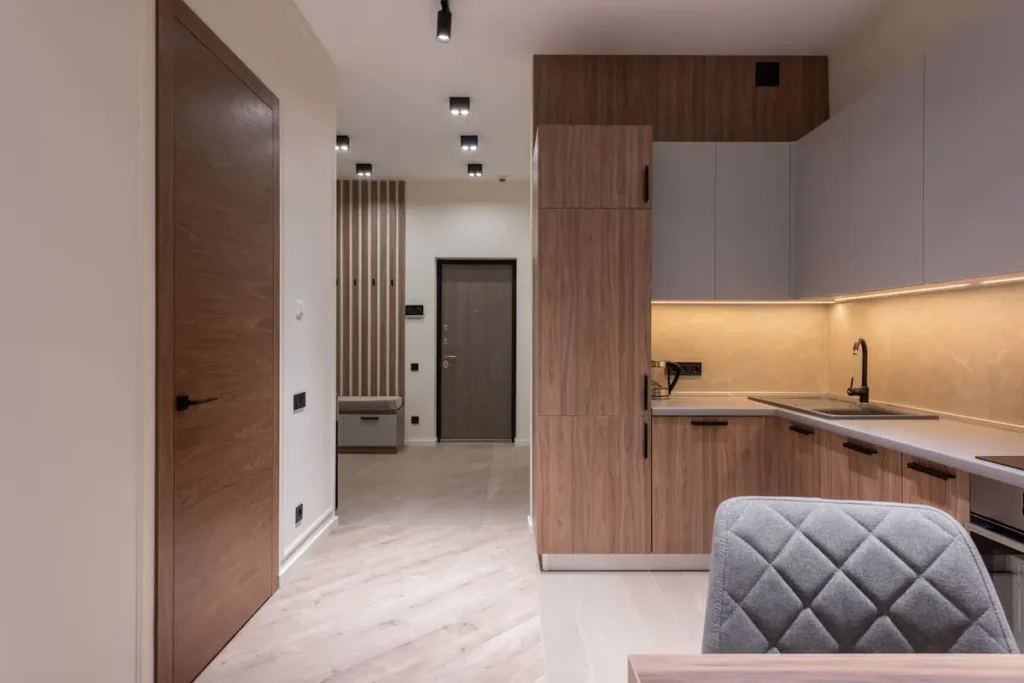When it comes to choosing materials for your home, “wood veneer vs laminate” is a decision that goes beyond looks. If you’re aiming to create a stylish yet sustainable space, this choice matters more than you might think.
Globally, the construction industry is responsible for about 39% of energy-related carbon emissions, and your material choices play a role in that footprint. Whether you’re designing a cozy living room or a functional kitchen, picking the right material can help minimize environmental impact without sacrificing style.
Each option—wood veneer or laminate—has its own benefits, costs, and environmental considerations. Veneers offer the warmth of natural wood, ideal for creating a timeless, organic look. At the same time, laminates provide durability and easy upkeep, perfect for busy spaces.
Here, we’ll explore the pros and cons of each, giving you the insights you need to make the best decision for both your home and the planet.
What is Wood Veneer?
Wood veneer is a thin layer of natural wood carefully cut and attached to a base material like plywood or MDF. This outer layer showcases the natural grain and texture of wood, making it a popular choice for those who want the look of solid wood without the cost. As the veneer is made from real wood, it provides a warm, authentic look that synthetic alternatives may not match.
From a sustainability standpoint, wood veneer is a more eco-friendly choice than some synthetic options. Wood is a renewable, biodegradable resource, especially when sourced responsibly. Look for veneer products certified by sustainable forestry organizations to ensure your purchase supports eco-conscious practices.
What is Laminate?
Laminate is a synthetic material made by fusing layers of paper or plastic with a printed design. Often bonded to a similar core material as veneer, laminate has a durable, protective outer layer that resists scratches and stains, making it ideal for high-traffic areas.
One of laminate’s main advantages is its affordability. Because it’s made with synthetic materials, laminate is usually less expensive than wood veneer.
However, this affordability can come with environmental concerns. Some laminates are non-biodegradable and may emit volatile organic compounds (VOCs). If sustainability is a priority, look for low-VOC laminates or those made from recycled materials.
Wood Veneer vs Laminate: Key Differences
1. Appearance and Feel
Wood veneer has an authentic wood look and feel, offering natural grains and textures that synthetic materials may not replicate. Laminate, while highly customizable with a range of styles and colors, often lacks the depth and warmth of real wood.
2. Durability
Laminate is highly durable and scratch-resistant, making it a great choice for busy spaces. Wood veneer, while aesthetically pleasing, is more susceptible to wear and may require more upkeep to maintain its look.
3. Cost
Laminate tends to be more budget-friendly than wood veneer. However, the upfront savings might come at a higher environmental cost, especially if the laminate isn’t sourced from eco-friendly materials.
4. Environmental Impact
Wood veneer, when responsibly sourced, is more eco-friendly, as it uses real wood, a renewable resource. Laminates can be eco-friendly if made from recycled materials and low-VOC adhesives, but not all laminates meet these standards.
Pros and Cons of Wood Veneer
Pros
- Natural appearance and texture.
- Biodegradable, renewable resource.
- Offers a premium, warm look.
Cons
- Prone to scratches and fading over time.
- Higher maintenance than laminate.
- Generally more expensive than laminate.
Pros and Cons of Laminate
Pros
- Durable and low-maintenance.
- Affordable and easy to clean.
- Wide variety of colors and designs.
Cons
- Synthetic look and feel.
- May emit VOCs.
- Non-biodegradable and difficult to recycle.
Choosing Between Wood Veneer and Laminate
Choosing between wood veneer and laminate depends on your priorities, as each material has strengths that suit different needs and lifestyles. If you value a natural, warm look with the authentic feel of wood grain, wood veneer might be the ideal choice. Veneer offers a richness and depth that only real wood can provide, which makes it perfect for creating an elegant, cozy ambiance in living rooms, studies, or dining spaces. Since wood veneer is made from natural wood layers, it also adds a unique character, with each piece showcasing subtle variations in grain and color.
On the other hand, laminate is often the go-to choice if you need durability and easy maintenance. Designed to resist scratches, stains, and moisture, laminate holds up well in high-traffic areas like kitchens, bathrooms, and kids’ rooms. Unlike wood veneer, laminate doesn’t fade as easily and can withstand more wear and tear. It’s a smart, budget-friendly option for busy households, offering a variety of colors, patterns, and finishes that can mimic wood or create modern, minimalist looks.
Budget is another factor to consider. Wood veneer tends to be more costly, both in upfront costs and maintenance, as it may require periodic polishing or touch-ups to retain its appearance. Laminate, however, is generally more affordable and demands less upkeep. A quick wipe-down is usually enough to keep it looking fresh.
Ultimately, think about where and how you plan to use the material. If you want a luxurious, timeless look, wood veneer is an investment that pays off in style and warmth. For practicality and resilience in active spaces, laminate offers a worry-free solution.
Conclusion: Wood Veneer vs Laminate
Both wood veneer and laminate have unique strengths, and choosing between them depends on your personal needs. Wood veneer brings warmth and a natural feel, perfect for a cozy home. Laminate is a tough, low-cost choice for busy spaces. Whichever you choose, there are eco-friendly options available.
By choosing a sustainable material that aligns with your values, you’re taking a step toward a more eco-friendly lifestyle. Every choice you make, from your furniture to your floors, adds to a more sustainable future. Choose wisely, and enjoy the beauty and comfort of a greener home.
